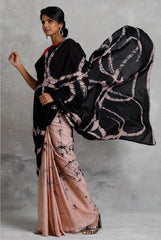
Batik Sarees at Dailybuyys
Posted on August 09 2022
One of the most ancient art form that is so unique to the Asian continent is Batik. Originally born in Java, Indonesia, this craft has a versatility as interesting as it's origin story.

Batik is a Javanese word. It came from the Javanese "ambatik" that consist of "amba" which means "wide" or "large", and "tik" or "nitik" means "dot" or "make a dot". The word "bathikan" also means "drawing" or "writing" in Javanese. As the word gradually got absorbed to Malay (including both Indonesian and Malaysian standards), the "th-" sound got reduced to a "t-" which was easy to pronounce to non-Javanese speakers.
The word batik found its first record in English in the Encyclopædia Britannica of 1880, in which it is spelled as battik. It is attested in the Indonesian Archipelago during the Dutch colonial period in various forms such as mbatik, mbatek, batik and batek. Batik known as "euyeuk" in Sundanese, cloth can be processed into a form of batik by a "pangeyeuk" the batik maker.
Although Indonesia holds the reigning position for producing the finest batik designs, yet according G. P. Rouffaer argues that the technique might have been introduced during the 6th or 7th century from India or Sri Lanka. 
Types of Batik:
Tuli Batik - It is made by writing wax liquid on the surface of the cloth with a tool called canting. Canting made of copper with a handle made of bamboo or wood. The making of hand-written batik takes approximately 1–3 months depending on the complexity and detail of batik. Because the working techniques are still traditional and manual, making hand-written batik takes longer and is more complicated than other batik techniques. In addition, the fundamental difference between written batik compared to other batik is that there are differences in each pattern, for example, a number of points or curved lines that are not the same because they are made manually. This characteristic of hand-written batik makes hand-written batik more valuable and unique compared to other batiks.

Stamp or Block Batik - It is batik whose manufacturing process uses a stamp tool. This stamp tool is made of copper plates which form a batik motif on one of its surfaces. Stamp tool or canting cap is made by people who are experts in that field. Making batik with cap works the same way as using a stamp or block, but using waxes, not ink. This experience process is not easy to do. To make one piece of batik cloth, the process of deepening is carried out several times depending on the number of colors desired.[31] Cap is used to replacing the canting function so that it can shorten the manufacturing time. Batik cap is produced from the process of dyeing a tool made of copper which has been shaped in such a way on the cloth. The batik cap motif is considered to have less artistic value because all the motifs are exactly the same. The price of printed batik is cheaper than written batik because it can be made en masse.

Painted batik - is a technique of making batik by painting (with or without a pattern) on a white cloth using a medium or a combined medium like canting, brush, banana stalk, broomsticks, cotton, toothpicks, patchwork, or other media depending on the expression of a painter. Batik painting is the result of the development of batik art. The essence of batik painting is the process of making batik that does not use traditional motifs that are commonly found. The resulting motifs are the creation of the maker, usually producing contemporary (free) motifs or patterns with brighter, more striking colors, and more diverse color variations. The coloring in painted batik tends to be free and plays with many colors that are not often found in written batik (batik tulis). There are also gradation effects and other painting effects. The drawings are made as if painted batik is an ordinary painting poured on cloth using wax as the medium. In principle, painted batik is almost the same way with written batik in the making process. Because of the development of classic written batik, painted batik still contains the same elements as written batik in the aspects of materials, processing, coloring, and highlighting (removing the wax). But there are also many differences due to the influence of modern painting, such as in terms of appearance, especially in motifs and colors. The most important thing in making painted batik is the combination of the batik work and coloring depending on the taste of the batik maker. Painted batik is popular because it has a very affordable price and a very creative manufacturing process. Painted batik can be used as decoration or ready-to-wear clothing (fashion). Painted batik which has human objects, landscapes, still objects, and other objects, are in high demand for display paintings.

The batik tulis and batik cap techniques are recognized by UNESCO as a Masterpiece of Oral and Intangible Heritage of Humanity from Indonesia because it still uses waxes in the making process.
At Dailybuyys we produce authentic batik designs produced by hand at our very production house on cottons and silks and tussars.
Our journey with batik started from as long as we could remember. Being a part of Bengal means being is close contact with Batik art owing to the connection of batik with Shantiniktan. Always being fascinated by the uniqueness of the designs produced using wax and colours, it definitely was one of the genres we were most excited about. Our abled and skilled Batik artisan produces each designs by hand and with meticulous labour. Some takes even upto ages to be completed but the product earned is always the finest.
We offer unique and exclusive designs. Come explore and shop from our wide variety of Batik sarees.




0 comments